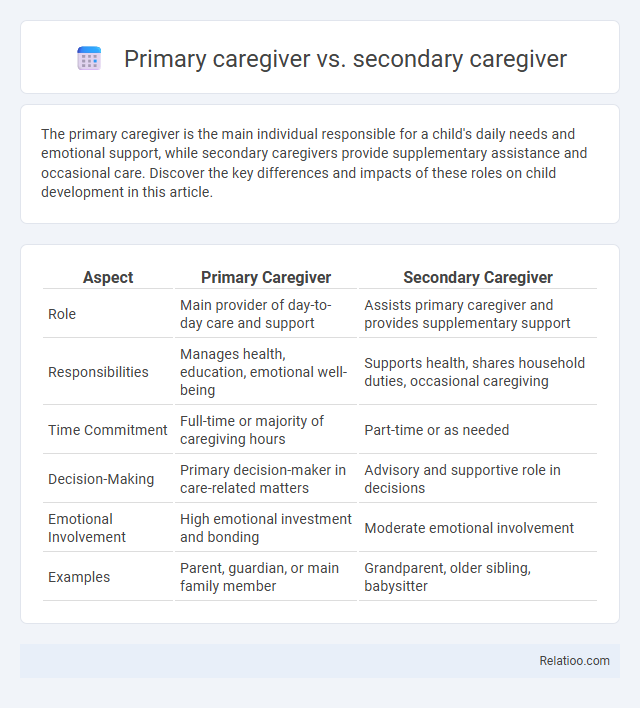The primary caregiver is the main individual responsible for a child's daily needs and emotional support, while secondary caregivers provide supplementary assistance and occasional care. Discover the key differences and impacts of these roles on child development in this article.
Table of Comparison
| Aspect | Primary Caregiver | Secondary Caregiver |
|---|---|---|
| Role | Main provider of day-to-day care and support | Assists primary caregiver and provides supplementary support |
| Responsibilities | Manages health, education, emotional well-being | Supports health, shares household duties, occasional caregiving |
| Time Commitment | Full-time or majority of caregiving hours | Part-time or as needed |
| Decision-Making | Primary decision-maker in care-related matters | Advisory and supportive role in decisions |
| Emotional Involvement | High emotional investment and bonding | Moderate emotional involvement |
| Examples | Parent, guardian, or main family member | Grandparent, older sibling, babysitter |
Defining Primary and Secondary Caregivers
Primary caregivers are individuals who provide the main source of care and support to someone with physical, emotional, or medical needs, often taking full responsibility for daily activities and decision-making. Secondary caregivers assist the primary caregiver by offering additional support, respite, or specialized care, usually sharing some caregiving duties without being the main provider. Defining primary and secondary caregivers helps clarify roles in caregiving dynamics, ensuring proper resource allocation, support systems, and effective care management.
Key Responsibilities of Primary Caregivers
Primary caregivers bear the key responsibility of managing daily care tasks such as medication administration, feeding, and coordinating medical appointments, ensuring the well-being and safety of the care recipient. Unlike secondary caregivers who provide occasional support or respite care, the primary caregiver often oversees long-term health monitoring and emotional support. Your role as a primary caregiver involves continuous commitment to addressing both physical and emotional needs, making it essential to balance caregiving duties with your own health and resources.
Core Duties of Secondary Caregivers
Secondary caregivers primarily support the primary caregiver by assisting with tasks such as medication management, transportation to medical appointments, and providing emotional support to the care recipient. Their duties often include respite care to prevent caregiver burnout and helping with household chores or meal preparation to maintain a stable living environment. Unlike primary caregivers who handle day-to-day personal care, secondary caregivers play a crucial role in sharing responsibilities and ensuring continuity of care.
Differences Between Primary and Secondary Caregiving Roles
Primary caregiving involves being the main provider of daily care, making key decisions, and managing healthcare needs, while secondary caregiving supports and assists with tasks as needed. Your role as a primary caregiver includes significant emotional and physical responsibilities, whereas secondary caregivers typically offer occasional relief or specific help. Understanding these differences can improve coordination and ensure comprehensive care for the individual.
Legal and Custodial Implications
Primary caregivers hold the majority of custodial rights and legal responsibilities for the child's welfare, often recognized by courts as having authority over major decisions related to education, healthcare, and daily care. Secondary caregivers typically have limited or no formal legal custody, restricting their ability to make binding decisions without consent from the primary caregiver or legal guardians. Understanding these distinctions is crucial for protecting your rights and ensuring clear legal standing in caregiving arrangements, especially during custody disputes or when drafting caregiving agreements.
Impact on Child Development
Primary caregivers play a crucial role in early child development by providing consistent emotional support and meeting a child's basic needs, fostering secure attachment and cognitive growth. Secondary caregivers contribute by offering supplementary social interactions and diverse learning experiences that enhance the child's adaptability and social skills. Your understanding of the distinct impacts each caregiver has can help optimize developmental outcomes and create a nurturing environment for the child.
Emotional Bonds and Caregiver Attachment
Primary caregivers develop the strongest emotional bonds and deepest caregiver attachment with you due to their consistent presence and hands-on support in daily activities. Secondary caregivers supplement this relationship by providing occasional assistance, fostering emotional connections that are supportive but less intense. Understanding these dynamics in caregiving roles helps optimize emotional well-being and attachment for both the caregiver and the care recipient.
Challenges Faced by Primary vs Secondary Caregivers
Primary caregivers often face intense physical and emotional challenges due to their constant, hands-on involvement in daily care tasks, managing medical appointments, and providing emotional support. Secondary caregivers typically encounter difficulties balancing caregiving duties with their personal and professional lives, leading to stress and feelings of guilt for not being more present. Your ability to navigate these distinct challenges impacts both the quality of care provided and the well-being of both caregivers.
Supporting Communication and Cooperation Between Caregivers
Effective support for communication and cooperation between primary and secondary caregivers enhances the quality of care by ensuring consistency and holistic attention to the care recipient's needs. Utilizing shared care plans, regular updates, and collaborative decision-making fosters trust and minimizes conflicts, promoting a unified caregiving approach. Digital communication tools and structured meetings empower caregivers to coordinate tasks, share observations, and respond promptly to changes in health or behavior.
Tips for Balancing Caregiving Roles
Balancing roles between primary and secondary caregivers requires clear communication and defined responsibilities to prevent burnout and ensure consistent care. Primary caregivers often handle daily care tasks and medical needs, while secondary caregivers provide supplementary support such as respite care or managing errands. Implementing schedules, sharing emotional support, and utilizing community resources can optimize caregiving efficiency and maintain caregiver well-being.

Infographic: Primary caregiver vs secondary caregiver
 relatioo.com
relatioo.com